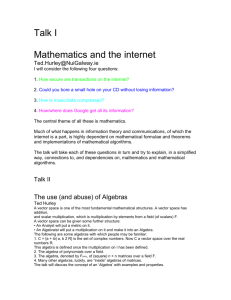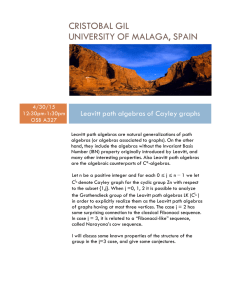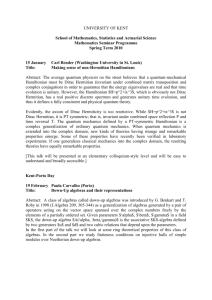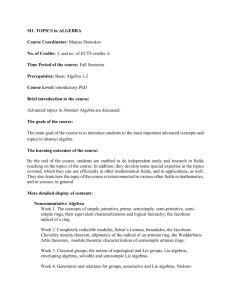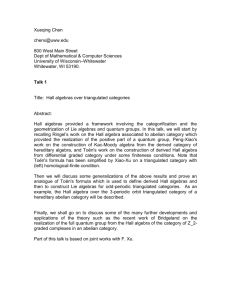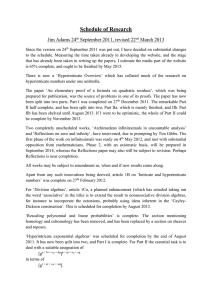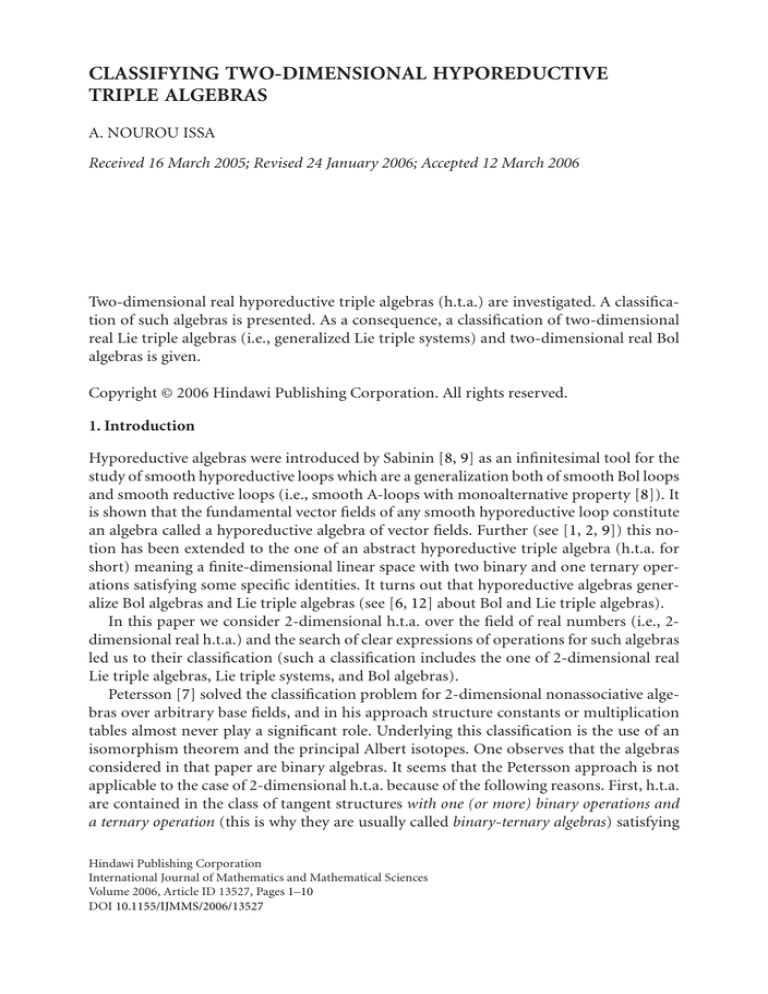
CLASSIFYING TWO-DIMENSIONAL HYPOREDUCTIVE
TRIPLE ALGEBRAS
A. NOUROU ISSA
Received 16 March 2005; Revised 24 January 2006; Accepted 12 March 2006
Two-dimensional real hyporeductive triple algebras (h.t.a.) are investigated. A classification of such algebras is presented. As a consequence, a classification of two-dimensional
real Lie triple algebras (i.e., generalized Lie triple systems) and two-dimensional real Bol
algebras is given.
Copyright © 2006 Hindawi Publishing Corporation. All rights reserved.
1. Introduction
Hyporeductive algebras were introduced by Sabinin [8, 9] as an infinitesimal tool for the
study of smooth hyporeductive loops which are a generalization both of smooth Bol loops
and smooth reductive loops (i.e., smooth A-loops with monoalternative property [8]). It
is shown that the fundamental vector fields of any smooth hyporeductive loop constitute
an algebra called a hyporeductive algebra of vector fields. Further (see [1, 2, 9]) this notion has been extended to the one of an abstract hyporeductive triple algebra (h.t.a. for
short) meaning a finite-dimensional linear space with two binary and one ternary operations satisfying some specific identities. It turns out that hyporeductive algebras generalize Bol algebras and Lie triple algebras (see [6, 12] about Bol and Lie triple algebras).
In this paper we consider 2-dimensional h.t.a. over the field of real numbers (i.e., 2dimensional real h.t.a.) and the search of clear expressions of operations for such algebras
led us to their classification (such a classification includes the one of 2-dimensional real
Lie triple algebras, Lie triple systems, and Bol algebras).
Petersson [7] solved the classification problem for 2-dimensional nonassociative algebras over arbitrary base fields, and in his approach structure constants or multiplication
tables almost never play a significant role. Underlying this classification is the use of an
isomorphism theorem and the principal Albert isotopes. One observes that the algebras
considered in that paper are binary algebras. It seems that the Petersson approach is not
applicable to the case of 2-dimensional h.t.a. because of the following reasons. First, h.t.a.
are contained in the class of tangent structures with one (or more) binary operations and
a ternary operation (this is why they are usually called binary-ternary algebras) satisfying
Hindawi Publishing Corporation
International Journal of Mathematics and Mathematical Sciences
Volume 2006, Article ID 13527, Pages 1–10
DOI 10.1155/IJMMS/2006/13527
2
Classifying two-dimensional hyporeductive triple algebras
some compatibility conditions. Thus, if the Petersson approach could be applied to the
binary operations of h.t.a. (under some conditions), it does not work, in general, for the
ternary operation of h.t.a. (e.g., we still do not know what the principal Albert isotope
of a ternary operation of an algebra is). Next, even for Bol algebras which are a very particular instance of h.t.a., almost no classification results are known (the classification of
2-dimensional real Bol algebras given in the present paper seems to be, to our knowledge,
the first one so far). Because of the nature of h.t.a., their classification over arbitrary base
fields should generalize, for example, the one of Bol algebras over arbitrary base fields
but, unfortunately, the latter is still not available in litterature. The other reason for considering in this paper only real h.t.a. is related to the correspondence between h.t.a. and
smooth hyporeductive loops [10] (this problem is solved by Kuz’min [5] for real finitedimensional Malcev algebras and smooth Moufang loops and by Miheev and Sabinin [6]
for real finite-dimensional Bol algebras and smooth Bol loops).
In Section 2 some results on hyporeductive algebras are recalled and the classification
theorem is stated. Section 3 deals with its proof (this proof gives the classification strategy).
2. Background and results
Hyporeductive algebras were originally introduced [8, 9] as algebras of vector fields on a
smooth finite-dimensional manifold, satisfying a specific condition. More exactly it was
given the following definition.
Definition 2.1 [8, 9]. A linear space V of vector fields on a real n-dimensional manifold
M with a singled out point e, satisfying
X,[Y ,Z] = X,a(Y ,Z) + r(X;Y ,Z)
(2.1)
is called a hyporeductive algebra of vector fields with determining operations a and r if
dim{X(e) : X ∈ V } = n.
Obviously a(Y ,Z) is a bilinear skew-symmetric operation and r(X;Y ,Z) a trilinear
operation on V , skew-symmetric in the last two variables. We called the relation (2.1) the
hyporeductive condition for algebras of vector fields (see [1, 2]). Considering a hyporeductive algebra as a tangent algebra at the identity e of a smooth hyporeductive loop it
is shown [9, 10] that a hyporeductive algebra may be viewed as an algebra with two binary operations a(X,Y )(e), Te (X,Y ) = [X,Y ](e) and one ternary operation r(Z;X,Y )(e)
and then, working out the Jacobi identities in the corresponding enveloping Lie algebra,
one can get the full system of identities linking the operations a,Te ,r. A similar construction is carried out in [1, 2], where instead of Te (X,Y ) the operation b(X,Y ) =
[X,Y ](e) − a(X,Y )(e) is introduced (this is made in connection with a more suitable
differential geometric interpretation of a hyporeductive algebra of vector fields and then
the system of identities mentioned above constitutes the integrability conditions of the
structure equations of the affinely connected smooth manifold associated with a local
smooth hyporeductive loop). Define the operations X · Y = a(X,Y )(e), X ∗ Y = b(X,Y ),
and Z;X,Y = r(Z;X,Y )(e), then (Te M, ·, ∗, ·; ·, ·) is an algebra satisfying the system
A. Nourou Issa 3
of identities mentioned above. This led us to introduce the notion of an abstract hyporeductive triple algebra (h.t.a.).
Definition 2.2 [1–3]. Let ᐂ be a finite-dimensional linear space. Assume that on ᐂ two
binary skew-symmetric operations “·,” “∗” and one ternary operation “ ; , ” skewsymmetric in the last two variables are defined. Say that the algebra (ᐂ, ·, ∗, ; , ) is an
abstract h.t.a. if for any ξ, η, ζ, κ, χ, θ in ᐂ the following identities hold:
σ ξ · (η · ζ) − ξ;η,ζ = 0,
(2.2)
σ ζ ∗ (ξ · η) = 0,
(2.3)
σ θ;ζ,ξ · η = 0,
(2.4)
κ · ζ;ξ,η − ζ · κ;ξ,η + ζ · κ;ξ,η
= ξ ∗ η;ζ,κ − ζ ∗ κ;ξ,η + ζ ∗ κ;ξ,η − κ ∗ ζ;ξ,η
(2.5)
+ (ξ ∗ η) ∗ (ζ ∗ κ) + (ξ ∗ η) · (ζ ∗ κ),
χ · κ · ζ;ξ,η − ζ · κ;ξ,η + ζ · κ;ξ,η
+ χ;ξ,η;ζ,κ − χ;ζ,κ;ξ,η + χ;ζ, κ;ξ,η − χ;κ, ζ;ξ,η = 0,
χ ∗ κ · ζ;ξ,η − ζ · κ;ξ,η + ζ · κ;ξ,η = 0,
θ;χ,κ · ζ;ξ,η − ζ · κ;ξ,η + ζ · κ;ξ,η = 0,
κ · ζ;ξ,η − ζ · κ;ξ,η + ζ · κ;ξ,η
+ η · ξ;ζ,κ − ξ · η;ζ,κ + ξ · η;ζ,κ = 0,
ζ ∗ κ;ξ,η − κ ∗ ζ;ξ,η + ξ ∗ η;ζ,κ − η ∗ ξ;ζ,κ = 0,
Σ
(2.10)
(2.11)
(2.12)
(2.13)
Σ θ; μ; η;ζ,κ,ξ − μ; ξ;ζ,κ,η ),λ
(2.9)
∗ μ = 0,
λ; ξ;ζ,κ,η − λ; η;ζ,κ,ξ
(2.8)
μ; η;ζ,κ,ξ − μ; ξ;ζ,κ,η ) ∗ λ
+
(2.7)
ξ · η;ζ,κ + η · ξ;ζ,κ − ξ · η;ζ,κ ;λ,μ
+ λ · μ; η;ζ,κ,ξ + μ · λ; η;ζ,κ,ξ − λ · μ; η;ζ,κ,ξ
− λ · μ; ξ;ζ,κ,η + μ · λ; ξ;ζ,κ,η − λ · μ; ξ;ζ,κ,η
= 0,
Σ
(2.6)
+ θ; λ; ξ;ζ,κ,η − λ; η;ζ,κ,ξ ,μ
= 0,
where σ denotes the sum over cyclic permutations of ξ, η, ζ and Σ the one on pairs (ξ,η),
(ζ,κ), (λ, μ).
Remark 2.3. The study of h.t.a. is more tractable if they are given in terms of identities as
in the definition above. For instance, we observe that if in (2.2)–(2.13) we set ξ · η = 0 for
4
Classifying two-dimensional hyporeductive triple algebras
any ξ, η of ᐂ, then we get the defining identities of a Bol algebra (ᐂ, ∗, ; , ):
σ ξ;η,ζ = 0,
ξ ∗ η;ζ,κ − ζ ∗ κ;ξ,η + ζ ∗ κ;ξ,η − κ ∗ ζ;ξ,η + (ξ ∗ η) ∗ (ζ ∗ κ) = 0,
χ;ξ,η;ζ,κ − χ;ζ,κ;ξ,η + χ;ζ, κ;ξ,η − χ;κ, ζ;ξ,η = 0.
(2.14)
On the other hand, setting ξ ∗ η = 0, we get a Lie triple algebra (i.e., a generalized Lie
triple system) (ᐂ, ·, ; , ):
σ ξ · (η · ζ) − ξ;η,ζ = 0,
σ θ;ζ,ξ · η = 0,
κ · ζ;ξ,η − ζ · κ;ξ,η + ζ · κ;ξ,η = 0,
(2.15)
χ;ξ,η;ζ,κ − χ;ζ,κ;ξ,η + χ;ζ, κ;ξ,η − χ;κ, ζ;ξ,η = 0
and if, moreover, we put ξ · η = 0 then we obtain a Lie triple system (L.t.s.) (see Yamaguti
[11]). Note that for ξ ∗ η = 0 and ξ · η = 0, the identities (2.9)–(2.13) hold trivially.
The question naturally arises whether there exist proper abstract h.t.a. The answer
to this problem is easier to seek among low-dimensional h.t.a. because of the specific
properties of operations “·,” “∗,” and “ ; , .” Thus we are led to the study of twodimensional real h.t.a., that is, to find the clear expressions of their defining operations.
The following classification theorem describes, up to isomorphisms, all 2-dimensional
real h.t.a. Such a classification includes the one of 2-dimensional real Bol algebras, Lie
triple algebras and Lie triple systems.
Theorem 2.4. Any 2-dimensional real h.t.a. is isomorphic to one of the h.t.a. of the following
types:
(I) u ∗ v = 0, u · v = 0, u;u,v = eu + f v, v;u,v = ku − ev,
(II) u ∗ v = 0, u · v = au, u;u,v = 0, v;u,v = ku, (a = 0),
(III) u ∗ v = 0, u · v = au + bv, u;u,v = 0, v;u,v = 0, (a = 0, b = 0),
(IV) u ∗ v = 0, u · v = au + bv, u;u,v = eu + f v, v;u,v = ku − ev, (a = 0, b = 0,
e = 0, f = 0, k = −e, a f − be = 0 = bk + ae),
(V) u ∗ v = cu + dv, u · v = 0, u;u,v = eu + f v, v;u,v = ku − ev, ((c,d) = (0,0)),
(VI) u ∗ v = cu + dv, u · v = au, u;u,v = 0, v;u,v = ku, (a = 0, (c,d) = (0,0)),
(VII) u ∗ v = cu + dv, u · v = au + bv, u;u,v = eu + f v, v;u,v = ku − ev, (a = 0, b = 0,
e = 0, f = 0, k = 0, (c,d) = (0,0), a f − be = 0 = bk + ae),
(VIII) u ∗ v = cu + dv, u · v = au + bv, u;u,v = 0, v;u,v = 0, (a = 0, b = 0, (c,d) =
(0,0)),
where a, b, c, d, e, f, k are real numbers.
Remark 2.5. The algebras of types (I), (II), (III), and (IV) are 2-dimensional real Lie triple
algebras, the zero algebra and 2-dimensional Lie triple systems are contained in type (I).
A comprehensive classification of 2-dimensional complex Lie triple systems is given by
Yamaguti [11] (indeed, type (I) above is just [11, Lemma 5.1] when the base field is the
A. Nourou Issa 5
one of real numbers); see also Jacobson [4]. Note that types (II), (IV) are nontrivial real
Lie triple algebras. The algebras of type (V) constitute nontrivial 2-dimensional real Bol
algebras (see Corollary 2.7 below).
Corollary 2.6. There exist nontrivial 2-dimensional real h.t.a. Moreover, any such an
algebra is isomorphic to an algebra of type (VI), (VII), or (VIII).
At this point we note that the example of a 2-dimensional real h.t.a. that we gave in
[3] is isomorphic to the algebra of type (VI) given by u ∗ v = dv, u · v = u, u;u,v = 0,
v;u,v = −u, (d = 0).
The subject of this paper is originally motivated by the need of showing concrete nontrivial h.t.a. Besides, an affine connection space locally permitting a structure of h.t.a. of
vector fields is already described in [2] and, conversely, the structure equations of such
an affine connection space give rise to a h.t.a. structure on the tangent space at a given
point of the manifold. In relation with this, we consider here an example of such an affine
connection space with a local loop structure [6] with the sole condition that is given a
skew-symmetric bilinear function on the space of certain vector fields.
Let (U, ◦,e) be a smooth local loop so that U is a sufficiently small neighborhood of
the fixed point e of a real n-dimensional manifold M. We may consider on U the socalled right fundamental vector fields {Xσ } of the loop (U, ◦,e) (see, e.g., [10] and references therein), [Xσ (x)]τ = Xστ (x), x ∈ U. Since Xστ (e) = δστ and e is a two-sided identity
of (U, ◦,e), it follows that X1 ,...,Xn define a basis of vector fields linearly independent
at each point of U and thus U is parallelizable. The Lie bracket of two basis vector fields
γ
Xα , Xβ is [Xα ,Xβ ](x) = Cαβ (x)Xγ (x) (observe that, in contrast of the case of left-invariant
γ
vector fields of a Lie group, the Cαβ are functions of point [9, 10]). Now define on U the
(−)-connection ∇Z Y = 0 obtained from the parallelization, for any vector fields Y , Z on
U. Assume that on the space of all right fundamental vector fields on U is given a skewsymmetric bilinear function a(Y ,Z). The torsion T of the connection defined above has
the expression T(Y ,Z) = −[Y ,Z]. The vector field [Y ,Z] − a(Y ,Z) is defined on U and
so is the vector field [W,[Y ,Z] − a(Y ,Z)], where W,Y ,Z are right fundamental vector
fields on U. Therefore, with respect to the basis {X1 ,...,Xn }, we have the representation
Xl , X j ,Xk − a X j ,Xk
= rl,i jk Xi ,
(∗)
which means that a structure of a h.t.a. of vector fields is locally defined (this is the original definition of a hyporeductive algebra of vector fields [8–10]). The relation (∗) may
be written as
∇l T ijk − Tlsi T sjk + asjk (x) = −rl,i jk (x)
(∗∗)
for any x ∈ U, where the skew-symmetric tensor (asjk ) is defined by a(X j ,Xk ) = asjk Xs ,
(T sjk ) is the torsion tensor of the connection ∇ and ∇l T ijk denotes the covariant derivative
of the function T ijk by the vector field Xl . Since {X1 ,...,Xn } is a parallelization, the rl,i jk
are constants and the relation (∗∗) means that ∇m (∇l T ijk − Tlsi (T sjk + asjk )) = 0 at each
6
Classifying two-dimensional hyporeductive triple algebras
point of U. The structure equations of (U, ∇) in terms of the basis {X1 ,...,Xn } are then
1
dωi = T ijk ω j ∧ ωk ,
2
i
dT jk = ∇l T ijk ωl .
(2.16)
The integrability conditions for these equations (at the point e) are precisely the defining
identities, written in terms of structure constants, of an abstract h.t.a. and so the tangent
space Te M is provided with a h.t.a. structure (see [2] for the general case of an affine
connection space related with a smooth local hyporeductive loop).
Suppose now that dimM = 2 and choose the basis vector fields X1 ,X2 such that
1
2
1
)(e) = 1, (X1 T12
)(e) = −1, (X2 T12
)(e) = 1,
[X1 ,X2 ](e) = 2X1 (e) + X2 (e), (X1 T12
2
(X2 T12 )(e) = 0. Moreover, choose the skew-symmetric function a(Y ,Z) such that
a(X1 ,X2 )(e) = X1 (e) + X2 (e). Then, as indicated in the beginning of this section, we may
define on Te M two binary operations X1 · X2 = X1 + X2 , X1 ∗ X2 = X1 and, using (∗∗), a
ternary operation X1 ; X1 , X2 = −X1 + X2 , X2 ; X1 , X2 = X1 − X2 , where X1 := X1 (e) and
X2 := X2 (e). It is easy to see that the space Te M along with these operations constitutes a
h.t.a. of type (VII).
According to the remarks above we have also the following corollary.
Corollary 2.7. Any 2-dimensional real Lie triple algebra is isomorphic to one of the algebras of the following types:
(T1) u · v = 0, u;u,v = αu + βv, v;u,v = γu − αv,
(T2) u · v = u, u;u,v = 0, v;u,v = ku,
(T3) u · v = u + v, u;u,v = 0, v;u,v = 0,
(T4) u · v = au + bv, u;u,v = eu + f v, v;u,v = ku − ev, (a = 0, b = 0, e = 0, f = 0,
k = 0, a f − be = 0 = bk + ae).
Any 2-dimensional real Bol algebra is isomorphic to one of the algebras of the following types:
(B1) u ∗ v = 0, u;u,v = αu + βv, v;u,v = γu − αv,
(B2) u ∗ v = cu + dv, u;u,v = eu + f v, v;u,v = ku − ev,
(B3) u ∗ v = cu + dv, u;u,v = eu + f v, v;u,v = −ev,
(B4) u ∗ v = cu + dv, u;u,v = eu, v;u,v = ku − ev,
(B5) u ∗ v = cu + dv, u;u,v = eu, v;u,v = −ev,
(B6) u ∗ v = cu + dv, u;u,v = f v, v;u,v = ku,
(B7) u ∗ v = cu + dv, u;u,v = f v, v;u,v = 0,
(B8) u ∗ v = cu + dv, u;u,v = 0, v;u,v = 0,
(B9) u ∗ v = cu, u;u,v = eu + f v, v;u,v = ku − ev,
(B10) u ∗ v = cu, u;u,v = eu + f v, v;u,v = −ev,
(B11) u ∗ v = cu, u;u,v = eu, v;u,v = ku − ev,
(B12) u ∗ v = cu, u;u,v = eu, v;u,v = −ev,
(B13) u ∗ v = cu, u;u,v = f v, v;u,v = ku,
(B14) u ∗ v = cu, u;u,v = f v, v;u,v = 0,
(B15) u ∗ v = cu, u;u,v = 0, v;u,v = ku,
(B16) u ∗ v = cu, u;u,v = 0, v;u,v = 0,
(B17) u ∗ v = dv, u;u,v = eu + f v, v;u,v = −ev,
A. Nourou Issa 7
(B18) u ∗ v = dv, u;u,v = eu, v;u,v = ku − ev,
(B19) u ∗ v = dv, u;u,v = eu, v;u,v = −ev, where c = 0, d = 0, e = 0, f = 0, k = 0.
Types (B2)–(B19) constitute just the developed form of type (V).
3. Proof of Theorem 2.4
First we will prove the following lemma.
Lemma 3.1. If {x1 ,x2 } is a basis of a 2-dimensional real h.t.a. ᐂ, then the identities (2.2)–
(2.13) of abstract h.t.a. have the following form:
J x1 ,x2 − x1 · x2 ;x1 ,x2 + x1 · x2 ;x1 ,x2 − x2 · x1 ;x1 ,x2 = 0,
xi · J x1 ,x2 − xi ;x1 , x2 ;x1 ,x2
+ xi ;x2 , x1 ;x1 ,x2
= 0,
xi ∗ J x1 ,x2 = 0,
x j ;xi ,J x1 ,x2
= 0,
(3.1)
(3.2)
(3.3)
(3.4)
x1 · x2 ;x1 ,x2 − x1 · x2 ;x1 ,x2 + x2 · x1 ;x1 ,x2 = 0,
(3.5)
J x1 ,x2 = 0,
(3.6)
where J(x1 ,x2 ) = x1 ∗ x2 ;x1 ,x2 − x2 ∗ x1 ;x1 ,x2 and i, j = 1,2.
Proof. With respect to the basis {x1 ,x2 }, (2.2), (2.3), and (2.4) are clearly satisfied trivially.
Next the left-hand side of (2.5) now reads xi · x j ;x1 ,x2 − x j · xi ;x1 ,x2 + x j · xi ;x1 ,x2 while the right-hand side reads x1 ∗ x2 ;x j ,xi − x j ∗ xi ;x1 ,x2 + x j ∗ xi ;x1 ,x2 − xi ∗
x j ;x1 ,x2 + (x1 ∗ x2 ) ∗ (x j ∗ xi ) + (x1 ∗ x2 ) · (x j ∗ xi ), with i, j = 1,2. Furthermore, because of the skew-symmetry of operations “· ,” “∗,” “ ; , ” one observes that the identity
(2.5) gets the form x1 ∗ x2 ;x1 ,x2 − x2 ∗ x1 ;x1 ,x2 = x1 · x2 ;x1 ,x2 − x1 · x2 ;x1 ,x2 +
x2 · x1 ;x1 ,x2 , so we obtain (3.1). In view of (3.1), the identities (2.7) and (2.8) are
straightforwardly transformed into (3.3) and (3.4), respectively.
Finally, and again with (3.1) in mind, we work the identity (2.6) as follows: we replace
ξ, η, ζ, κ, χ by x1 , x2 , xk , x j , xi , respectively, where i, j,k = 1,2 and then by (3.1), we
see that (2.6) gets the form xi · (x1 ∗ x2 ;x1 ,x2 − x2 ∗ x1 ;x1 ,x2 ) + xi ;x2 , x1 ;x1 ,x2 −
xi ;x1 , x2 ;x1 ,x2 = 0, that is, we get (3.2). The equation (2.10) implies (3.6) and hence
(3.5), in view of (3.1). The equalities (2.11)–(2.13) hold trivially in view of (3.6) and
(3.2).
One observes that (3.5) and (3.6) are actually equivalent and accordingly the system
(3.1)–(3.6) takes a simpler form (see the theorem’s proof below). We keep the system
(3.1)–(3.6) as above in order to follow the step-by-step transformation of the system
(2.2)–(2.13) in the 2-dimensional case. We now turn to the proof of the theorem.
Proof of Theorem 2.4. Let (ᐂ, ·, ∗, ; , ) be a 2-dimensional real h.t.a. with basis {u,v}.
Put u · v = au + bv, u ∗ v = cu + dv, u;u,v = eu + f v, v;u,v = ku + lv. Then, by the
lemma, the identities (2.2)–(2.13) reduce to (3.1)–(3.6) and a careful reading of these
identities reveals that the expression N = u · v;u,v + v · u;u,v − u · v;u,v can be
8
Classifying two-dimensional hyporeductive triple algebras
conclusive for the study of h.t.a. (at least in the 2-dimensional case). Therefore we will
discuss the case N = 0 (see (3.5)).
Thus 0 = N = u · v;u,v + v · u;u,v − u · v;u,v = au + bv;u,v + v · (eu + f v) −
u · (ku + lv) = (bk − al)u + (a f − be)v implies
bk − al = 0,
a f − be = 0.
(3.7)
Discussing the solutions of the system (3.7), we see that the following essential situations
occur (any other situation is either one of those enumerated below or is included in some
of them):
(1) a = 0, b = 0, e = 0, f = 0, k = 0, l = 0,
(2) a = 0, b = 0, e = 0, f = 0, k = 0, l = 0,
(3) a = 0, b = 0, e = 0, f = 0, k = 0, l = 0,
(4) a = 0, b = 0, e = 0, f = 0, k = 0, l = 0,
(5) a = 0, b = 0, e any , f = 0, k = 0, l = 0,
(6) a = 0, b = 0, e = 0, f any, k = 0, l any,
(7) a = 0, b = 0, e any, f any, k any, l any.
Now each of the cases (1)–(7) must be discussed in connection with the identities
(3.1)–(3.6). We observe that with the condition N = 0 (i.e., (3.5)) only (3.1) and (3.2) are
of interest here.
The identity (3.1) implies u ∗ v;u,v − v ∗ u;u,v = 0 which means that
(e + l)u ∗ v = 0.
(3.8)
The equation (3.8) yields the following cases:
(8) u ∗ v = 0 and l = −e,
(9) u ∗ v = 0 and l = −e,
(10) u ∗ v = cu + dv ((c,d) = (0,0)) and l = −e.
Then considering each of the cases (1)–(7) in connection with the conditions (8)–(10),
we are led to the following types of algebras:
(A1) u ∗ v = 0, u · v = au + bv, u;u,v = eu + f v, v;u,v = ku + lv, (a = 0, b = 0,
e = 0, f = 0, k = 0, l = 0, l = −e, a f − be = 0 = bk − al),
(A2) u ∗ v = 0, u · v = au + bv, u;u,v = eu + f v, v;u,v = ku − ev, (a = 0, b = 0,
e = 0, f = 0, k = 0, a f − be = 0 = bk + ae),
(A3) u ∗ v = cu + dv, u · v = au + bv, u;u,v = eu + f v, v;u,v = ku − ev, (a = 0,
b = 0, (c,d) = (0,0), e = 0, f = 0, k = 0, a f − be = 0 = bk + ae),
(A4) u ∗ v = 0, u · v = au + bv, u;u,v = eu + f v, v;u,v = 0, (a = 0, b = 0, e = 0,
f = 0, k = 0, a f − be = 0),
(A5) u ∗ v = 0, u · v = au + bv, u;u,v = 0, v;u,v = ku + lv, (a = 0, b = 0, k = 0,
l = 0, bk − al = 0),
(A6) u ∗ v = 0, u · v = au + bv, u;u,v = 0, v;u,v = 0, (a = 0, b = 0),
(A7) u ∗ v = cu + dv, u · v = au + bv, u;u,v = 0, v;u,v = 0, (a = 0, b = 0, (c,d) =
(0,0)),
(A8) u ∗ v = cu + dv, u · v = au, u;u,v = 0, v;u,v = ku, (a = 0, (c,d) = (0,0)),
A. Nourou Issa 9
(A9) u ∗ v = 0, u · v = au, u;u,v = 0, v;u,v = ku, (a = 0),
(A10) u ∗ v = 0, u · v = au, u;u,v = eu, v;u,v = ku, (a = 0, e = 0),
(A11) u ∗ v = cu + dv, u · v = bv, u;u,v = f v, v;u,v = 0, (b = 0, (c,d) = (0,0)),
(A12) u ∗ v = 0, u · v = bv, u;u,v = f v, v;u,v = 0, (b = 0),
(A13) u ∗ v = 0, u · v = bv, u;u,v = f v, v;u,v = lv, (b = 0, l = 0),
(A14) u ∗ v = cu + dv, u · v = 0, u;u,v = eu + f v, v;u,v = ku − ev, ((c,d) = (0,0)),
(A15) u ∗ v = 0, u · v = 0, u;u,v = eu + f v, v;u,v = ku − ev,
(A16) u ∗ v = 0, u · v = 0, u;u,v = eu + f v, v;u,v = ku + lv, (l = −e).
Furthermore, the identity (3.2) implies x; u;u,v,v + x;u, v;u,v = 0 with x = u
or v, that is,
(e + l)x;u,v = 0,
(3.9)
x = u or v. The equation (3.9) gives the following cases:
(11) l = −e and x;u,v = 0, x = u or v,
(12) l = −e and u;u,v = 0, v;u,v = 0,
(13) l = −e and u;u,v = 0, v;u,v = 0,
(14) l = −e and x;u,v = 0, x = u or v,
(15) l = −e and x;u,v = 0, x = u or v.
Therefore, in view of constraints (11)–(15), the algebras of types (A1), (A4), (A5), (A10),
(A13), and (A16) must be cancelled out. Now, observing that an algebra of type (A8)
is isomorphic to the one of type (A11) and an algebra of type (A9) is isomorphic to
the one of type (A12), we are left with the algebras of types (A2), (A3), (A6), (A7), (A8),
(A9), (A14), (A15). These are precisely the ones enumerated in our classification theorem.
Acknowledgments
The author wishes to thank the referees for their comments and suggestions that helped
to improve the initial version of the present paper. Thank also goes to Petersson H. P. for
making his relevant article available.
References
[1] A. N. Issa, On the theory of hyporeductive algebras, Algebraic Methods in Geometry (and V. V.
Ryzhkov, et al., eds.), Collect. Sci. Works, Izd. Ross. Univ. Druzhby Narodov, Moskva, 1992, pp.
20–25.
, Notes on the geometry of smooth hyporeductive loops, Algebras, Groups and Geometries
[2]
12 (1995), no. 3, 223–246.
, A note on the Akivis algebra of a smooth hyporeductive loop, Quasigroups and Related
[3]
Systems 9 (2002), 55–64.
[4] N. Jacobson, Structure and Representations of Jordan Algebras, American Mathematical Society
Colloquium Publications, vol. 39, American Mathematical Society, Rhode Island, 1968.
[5] E. N. Kuz’min, On the relation between Mal’tsev algebras and analytic Moufang loops, Algebra
and Logic 10 (1971), no. 1, 1–14.
[6] P. O. Miheev and L. V. Sabinin, Quasigroups and differential geometry, Quasigroups and Loops:
Theory and Applications (O. Chein, H. O. Pflugfelder, and J. D. H. Smith, eds.), Sigma Ser. Pure
Math., vol. 8, Heldermann, Berlin, 1990, pp. 357–430.
10
Classifying two-dimensional hyporeductive triple algebras
[7] H. P. Petersson, The classification of two-dimensional nonassociative algebras, Results in Mathematics 37 (2000), no. 1-2, 120–154.
[8] L. V. Sabinin, On smooth hyporeductive loops, Soviet Mathematics. Doklady 42 (1991), no. 2,
524–526.
, Smooth hyporeductive loops, Webs and Quasigroups (Moscow, 1989), Tver. Gos. Univ.,
[9]
Tver, 1991, pp. 129–137.
, The theory of smooth hyporeductive and pseudoreductive loops, Algebras, Groups and
[10]
Geometries 13 (1996), no. 1, 1–24.
[11] K. Yamaguti, On algebras of totally geodesic spaces (Lie triple systems), Journal of Science of the
Hiroshima University, Series A 21 (1957), no. 2, 107–113.
, On the Lie triple system and its generalization, Journal of Science of the Hiroshima
[12]
University, Series A 21 (1958), no. 3, 155–160.
A. Nourou Issa: Département de Mathématiques, Université d’Abomey-Calavi,
01 BP 4521 Cotonou, Benin
E-mail address: woraniss@yahoo.fr

